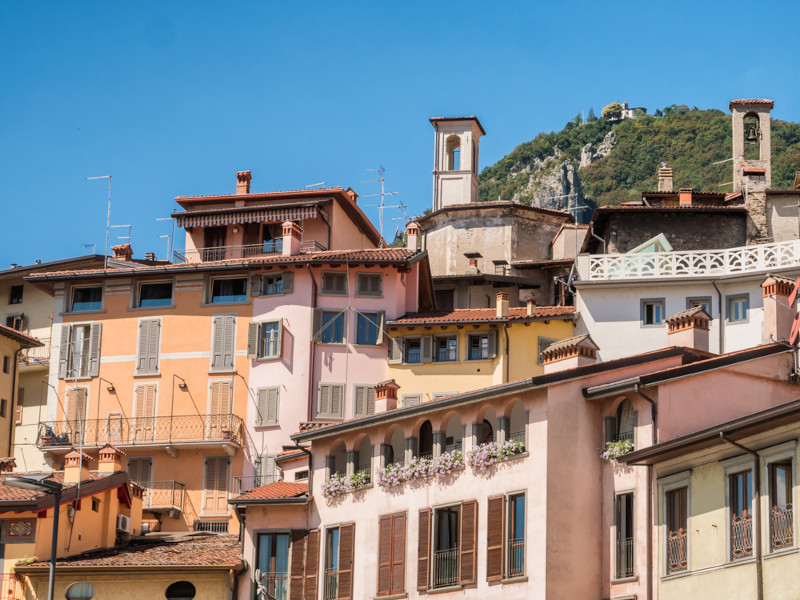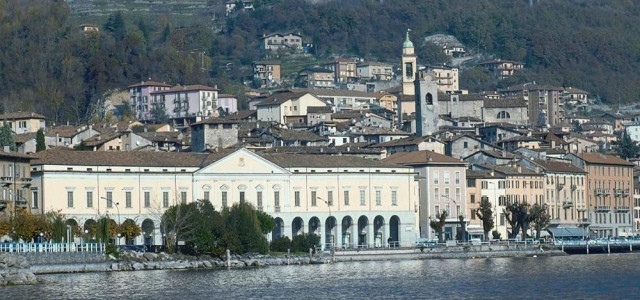Lovere
Lovere is a town and comune in the province of Bergamo, in Lombardy, Italy, at the northwest end of Lake Iseo. The houses in the city have overhanging wooden roofs, typical of Switzerland, united with the heavy stone arcades of Italy; it faces a lake and has a semicircle of mountains behind. Lovere is part of The most beautiful villages in Italy, an Association that notes small Italian towns of strong artistic and historical interest. History The first known settlement in Lovere area dates to the 5th and 4th century BC, being of Celtic origin. Later it was conquered by the Romans, attracted by its strategical position at the end of the Val Camonica and the beginning of the Val Cavallina, as well as for the naval transport on the Lake Iseo. After the fall of the Western Roman Empire it was ruled by the Lombards and the Franks. Given to the monks of the Marmoutier Abbey, it was sold to the Bishops of Bergamo, who, at the time of the Guelphs and Ghibellines struggle, were in turn replaced by the Celeri family. The fights lasted until the mid-15th century, when the territory was conquered by the Republic of Venice, whose rule lasted until the French invasion in 1797. The English aristocrat and writer Lady Mary Wortley Montagu spent ten years of her life on the shores of Lake Iseo. Main sights The church of Santa Maria in Valvendra, built in 1473, initially in Gothic style, then replaced by Renaissance forms. It has with a nave and two aisles, and houses paintings by Gian Paolo Cavagna, Domenico Carpinoni and Piero Marone. Palazzo Tadini contains a gallery of art including paintings by Giovanni Giacomo Barbelli, Giovanni Battista Crespi (also known as Il Cerano), Pietro Damini, Jacopo Ligozzi, Carlo Francesco Nuvolone, Santo Prunati, Pietro Ricchi, Elisabetta Sirani, Paris Bordone, Giacomo Ceruti, Antonio Cifrondi, Luigi Frisoni, Giuseppe Vittore Ghislandi (also known as Fra' Galgario), Giandomenico Tiepolo, Francesco Zugno and others. Paintings from the 19th century include works by Eduardo Arroyo, Bengt Lindstrom, Emilio Vedova and others. The palace is also home to marble sculptures by Giovanni Maria Benzoni, Johann Weigel, Andrea Chierici, Luciano Zambetti and Canova. The museum also contains a collection of terracotta, porcelain, antique armor and armaments, and furniture. Palazzo Tadini houses also a zoological collection. Church of San Giorgio, dating from 1263, although mostly rebuilt in the mid-15th century. It houses a Last Supper by Gian Paolo Cavagna and Trinity with the Virgin by Palma the Younger. Monastery of Santa Chiara, built in the early 16th century. It has some works by Sebastiano Conca. Oratory of San Martino, dating (according to some sources) to the 9th century, and including some recently rediscovered frescoes in the apse. The Castelliere, one of the most ancient fortifications in the region (3rd century BC). Economy Lovere possesses a metallurgic plant, Lucchini RS, which employs about 1300 people and specializes in the manufacture of railroad wheels and axles. Notable people 1906 Medicine Nobel Prize Camillo Golgi studied in Lovere's Liceo Classico. Giacomo Agostini, all-time leader in victories in motorcycle Grand Prix history, was born in Lovere in 1942. Leading cinema critic and RAI author Enrico Ghezzi was born in Lovere in 1952. External links Borghitalia website References This article incorporates text from a publication now in the public domain: Chisholm, Hugh, ed. (1911). Encyclopædia Britannica (11th ed.). Cambridge University Press.


